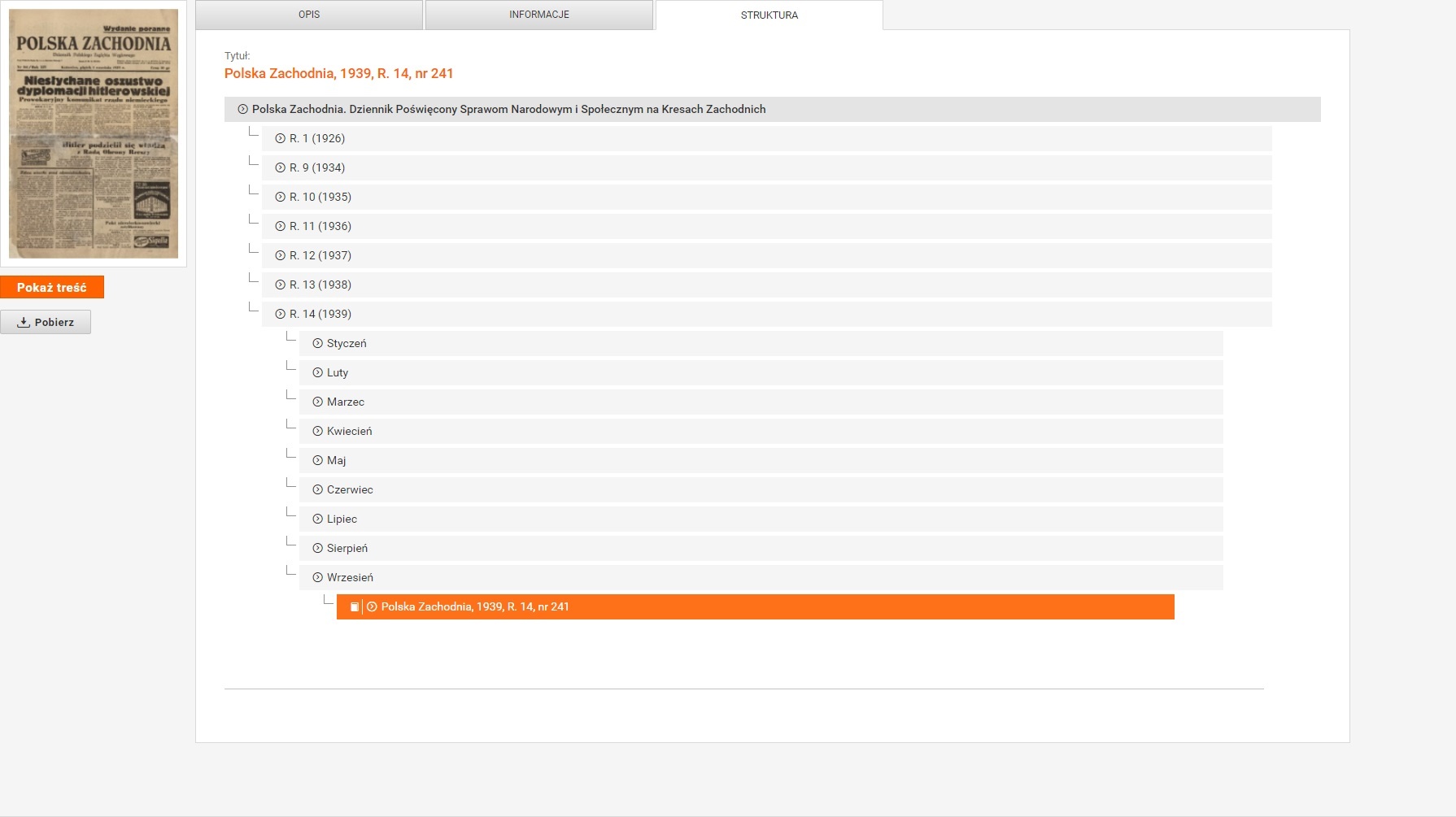The dLibra system offers its users many ways of finding digital objects. The basic one is the search function. It is also possible to browse the content of a dLibra digital library with the use of collections or word indexes. Moreover, every digital object in the dLibra system has its own, unique access link and an OAI identifier.
Local Search
The local search in the dLibra system is the basic search mechanism used by web page users. It is the simplest and user-friendliest method of finding the items which interest users. The mechanism looks for objects in the local resources and presents a list of the search results, beginning with the elements which are the best match for the search query. The mechanism searches the metadata and the publication text (if it is available). It is based on the Solr search engine. All properties of the search mechanism (for example, the construction of search queries, the factors which have an impact on the order of search results) are based on the Solr search engine. For more information about that engine, see its documentation.
Using a synonym dictionary
The local search also offers a mechanism for expanding search queries with words/phrases. For more information about that topic, see here.
Automatic Expansion of Queries
Queries are expanded automatically when the user’s question is matched to a synonym group. In such a case, the dLibra system completes the entered query by adding all the words/phrases from the selected synonym group. Let us illustrate it with an example. The user types in “Kopernik”. In the synonym dictionary, there is a “Copernicus” group. It contains two values, “Kopernik” and “Copernicus”. The search query in the index will have the following form: “Kopernik OR Copernicus”.
Filtering queries
All search results can be narrowed down with the use of additional filters. The available filters are displayed after every search query, on the search results page. The results can be narrowed down with respect to attributes, collections, group publications, and content formats.
Distributed Resource Search
Apart from the local search, there is an option of adding distributed resource search to a dLibra digital library. Distributed resources are searched based on the OAI-PMH protocol, with the use of the distributed resource search service of the Digital Library Federation portal.
For every search query, the query is sent to the DLF service. The best results are displayed under the results list of the local library. There is also an option of displaying all the results in the DLF service, by clicking the “More in DLF” button. The user will be redirected to the DLF service, and a list of the elements found in all DLF digital libraries will be displayed (the current list is published here). The “Digital Library Federation” service is another stage of the construction of the distributed network of digital libraries and repositories in Poland. The name of the DLF service reflects its nature it is a set of advanced network services based on the digital resources available in Polish digital libraries and repositories available in the PIONIER network. Those resources are co-created by many scientific and public institutions, such as higher education institutions, libraries, archives, musea, or research centers. The DLF service is maintained by the Poznań Supercomputing and Networking Center affiliated with the Institute of Bioorganic Chemistry of the Polish Academy of Sciences.
The Methods of Browsing the Resources of a dLibra Digital Library
Apart from searching for digital objects, the user can also find them and browse them in a couple of other ways. One other method is using collections, which are small, organized sets of digital objects. Most digital libraries based on the dLibra system organizes collections on the basis of the natural criterion of theme. The hierarchical structure of collections makes it possible to organize them from general sets to narrower, specific subsets (for example, from “Didactic materials” to “Mathematics” or “Physics”).
Objects can also be browsed with the use of indexes made up of all values of a given metadata attribute. The specific attributes used for generating indexes are selected so as to meet the needs of the institutions which make use of the given digital library. For example, indexes can be created on the basis of the “Author”, “Title”, “Theme”, and “Key words” attributes.
Complex objects (resulting from the use of a group publication) in the dLibra system are presented as a hierarchical structure, which can be easily navigated by the user. Thus, the user can access any part of the whole digital object. For example, if the object is a newspaper, the structure may look as follows.
Digital Object Permalink and Identifier
Every publication in the dLibra system has a unique link to a web page which always contains information about that publication. That page consists of the address of the website of the digital library, followed by the /publication/ string and the publication identifier. Such a link may look as follows: https://sbc.org.pl/publication/257008. This sample link consists of the https://sbc.org.pl website address, the /publication/ string, and the identifier of the publication in that digital library, 257008.
What is more, every publication in the dLibra system has an automatically generated, unique identifier which is based on the OAI Identifier open standard. Each such identifier consists of the oai prefix, the domain of the repository containing the given object, and a unique identifier in that repository. Those elements should be separated by colons (:). Thus, the identifier of the sample publication would have the following form: oai:sbc.org.pl:243088. That topic is discussed in detail in the OAI Identifier standard.


